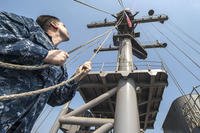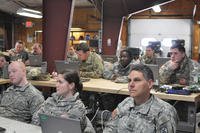A new type of athleticism is growing in popularity in the last 20 years, with more “extreme sports” becoming competitions.
Sports like BMX, motocross, skiing, snowboarding and skateboarding have turned fun hobbies into full-time sports and athletic activities for many young athletes. Many of these athletes are finding their way into the military as well. Here are some strengths and weaknesses found in the extreme athlete.
Extreme athlete's strengths for the military recruit (intangibles)
Mental toughness. There is a comfort level that extreme athletes have and is unlike many other types of athletes. Facing a steep ski slope, a halfpipe, high jumps and other dangerous maneuvers creates a person comfortable with high-risk activities. Thinking and performing physically under this “life-or-death” stress is a skill set not many athletes have.
Competitor/teammate. For extreme athletes, their competitions often are individual events, even though as they advance, they may be competing on a team representing the United States in an Olympic-type competition. Though the competitor side in the extreme athlete is high or higher than any athlete, the combining forces and becoming a team could prove difficult at first. But with some respected teammates, this type of athlete will create a unique bond and likely often be a source of fun party tricks for the crowd.
Injuries. A history of injuries is very likely for the athlete who has done this type of sports. Getting accepted into the military with multiple surgeries, broken bones and other injuries could make the Military Entrance Processing Station (MEPS) and medical waiver process more difficult.
But if you have all the medical records, physical therapist and doctor/surgical notes, you should be OK as long as you don't have a limited range of motion or severe back pain, for example. Crushing the physical fitness test (PFT) is one way to show recruiters that you are fully capable of joining the military. Many athletes bring a high pain threshold with them to the military and make for good recruits in combat units and special operations programs.
Extreme athlete’s strengths for the military recruit (tangibles)
Big core strength and cardio endurance. Depending upon the activity these athletes specialize in (some do more that one skill), the amount of core strength, balance, agility, dexterity and leg stamina will serve the extreme athlete well as they advance through the training pipeline.
Obstacle courses. Extreme athletes do exceptionally well with obstacle courses. Grip muscles for the rope climbs are easy, and they tend to weigh less and have long-lasting grip strength. Look for these athletes to have some of the faster obstacle-course times in the class.
Extreme athlete's weaknesses for the military recruit
Specifics. Depending upon the branch of service, as long as the typical extreme athlete does not need to swim, they will do quite well in the military. However, no matter what service, the extreme athlete will need to do calisthenics.
The advanced-level athletes often will have a background in body-weight exercises. However, these can be a temporary weakness if high-rep calisthenics are not part of a regular training cycle.
Injury prevention/running foundation building. The solid foundation of muscle stamina, core strength, endurance and grip strength enable the extreme athlete to have a strong foundation with joint strength in the lower and upper body. However, a typical weakness can be running or rucking longer distances at an accelerated pace. Hopefully, after extreme sports injuries, the rehab was sufficient, and being susceptible to typical traumatic injuries like sprains, falls, bumps and bruises will be part of the past.
Discipline and authority. Extreme athletes are from a culture (to a degree) of defying authority. Being yelled at during boot camp and transitioning into a team player with your fellow recruits may be a challenge at first. But with some maturity and patience, the transition into the military can be just as “smooth” as it is for everyone else.
Regardless of your athletic background, becoming a tactical athlete requires molding your current strengths to the service requirements and focusing on current weaknesses that could be detrimental to the new recruit or spec-ops student. If you are a current athlete, keep it up, but in the offseason, get specific to the branch of service that you are considering. You may need to add in some rucking, swimming, more speed and agility running, and perhaps lifting so the load-bearing events of rucking are not an uncommon event.
Previous athletes discussed:
Cross Country Endurance Running Athlete
Stew Smith is a former Navy SEAL and fitness author certified as a Strength and Conditioning Specialist (CSCS) with the National Strength and Conditioning Association. Visit his Fitness eBook store if you’re looking to start a workout program to create a healthy lifestyle. Send your fitness questions to stew@stewsmith.com.
Want to Learn More About Military Life?
Whether you're thinking of joining the military, looking for fitness and basic training tips, or keeping up with military life and benefits, Military.com has you covered. Subscribe to Military.com to have military news, updates and resources delivered directly to your inbox.
















